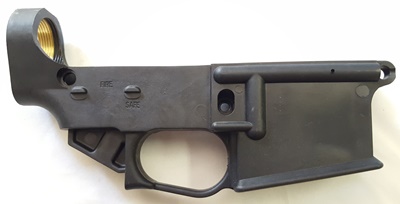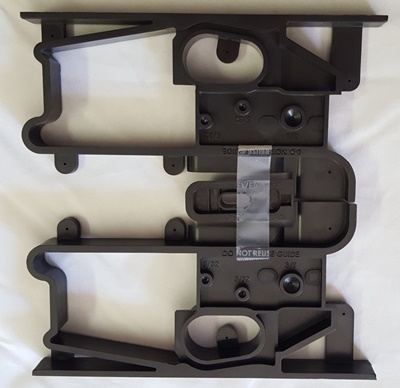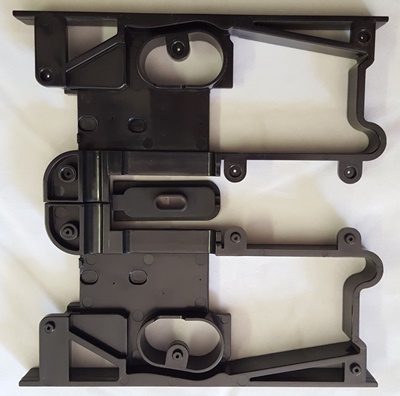Hybrid-80 Tennessee Arms Liberator 80% AR lower receiver review
Tennessee Arms Liberator 80% AR lower receiver
Price - $79
Material - reinforced nylon (Nylon 6-6 with 50% fiber fill), brass inserts
Finish - integrated into receiver
Color - matte black (also FDE, OD or Stealth Grey)
Rear pocket - completed
Trigger guard - integrated
Engravings - safe/fire
Notable features - brass inserts in pistol grip screw hole and receiver extension threads
Works with the 80% Arms Universal Easy Jig - yes
Works with the Modulus Arms Jig - yes






The Hybrid-80 Liberator is a reinforced polymer receiver manufactured and also sold by Tennessee Arms. While I believe the driving force behind this receiver blank is Hybrid-80 they do not sell it directly. It can however be purchased directly from Tennessee Arms as a blank and jig for $79. Depending on what tools and jig you may already have will probably influence which package you get. I received the blank and jig directly from Hybrid-80 but I would likely have purchased the blank only as I already have jigs and tooling from previous projects. I cannot speak about the end mill and drill bits in the full kit but I can tell you about the blank and jig I received.
First impressions:
Anyone familiar with Tennessee Arms will know that they produce high quality commercial polymer receivers. They have great customer service and quite a fan base on Reddit. I personally own several of their commercial receivers in various colors including one of the clear receivers they made for a time. This is the receiver I used in the video "How to Install AR-15 Lower Parts Kit & Buttstock". Not surprisingly this receiver blank is of the same quality as their other receivers. The polymer is extremely strong and the brass inserts in the pistol grip and receiver extension (buffer tube) area make installation of these parts much easier. Aesthetically the design of this lower might be described as stylized mil-spec. It more or less follows the lines of a standard forged receiver with only the integrated trigger guard being the major departure.
The jig that came with this package appears to be of the same material as the lower and is meant to be used with a traditional milling machine or the less recommended drill press. While I recommend against using a drill press as a milling machine for safety (drill presses are meant for vertical, not horizontal forces) if one is go against this advice it would be preferable to do it with a polymer receiver. The design of the jig is very similar to the jig used in the Polymer80 system. Basically a skeletonized frame that clamshells around the receiver and is secured by screws. The packages with a jig should include a hardware pack with five screws and nuts to hold the jig together. All packages should include a shorter grip screw as the brass insert in these and TNA lowers is too short for a traditional grip screw (though the shorter screws included with Magpul grips will work). The Hybrid-80 website has finishing instructions but they are not very detailed so you almost have to know what you are doing to understand them. If you decide to go this route it might be a good idea to watch the Polymer80 YouTube video showing how to mill out the G150 using their jig, drill bits and end mill using a drill press with an X-Y vise.
I decided to forgo the included jig and use the 80% Arms Easy Jig with the new steel bushing insert side plates. It had been a minute since I milled a polymer lower and it's always a pleasure because it's so much easier than aluminum. This was the first time I used a hand drill to pre-drill the fire control group pocket and to finish out the selector, hammer and trigger pin holes. I still prefer to use a drill press for these operations but since my chuck key is AWOL this seemed like a good opportunity to give the hand drill a try. Of course the milling with the router went smoothly and quickly with the polymer. For me, milling a polymer receiver saves a couple of hours of time as compared to an aluminum blank.
Final thoughts:
Being experienced with both polymer receivers in general and Tennessee Arms receivers specifically I was totally unsurprised by the Liberator. It was manufactured with the same quality I was accustomed to seeing in other TNA products and was as easy to machine as any receiver I have done. A polymer receiver may be a good option for first time 80percenters because it is so much easier to work with compared to aluminum. Walk before you run, though it may seem counter-intuitive to use that phrase as polymer machining is more like running while the slow going of aluminum is more like walking. Unless an inferior grade polymer is used, or there is an accidental void introduced in the mold, modern reinforced polymers should have all the strength needed for an AR receiver which doesn't carry a lot of stress by design anyway. The only issue I have run across with some polymer receivers is the possible need to re-machine some areas such as the takedown/pivot pin detent holes. But if you're willing to go the 80% route I would think small operations like that wouldn't be of too much concern.
Even though it will be obvious from the TNA website that the Liberator costs about twice as much as their commercial-ready product compared to other polymer 80% receiver blanks it is a good value. It's right in line with the James Madison Tactical lower if you factor in the jig but can also be had without the jig for $25 less. It is more than the Polymer80 G150 though which is about $30 less for a similar kit with jig and tooling or $15 less for the receiver blank alone.
80% lower receiver comparison chart